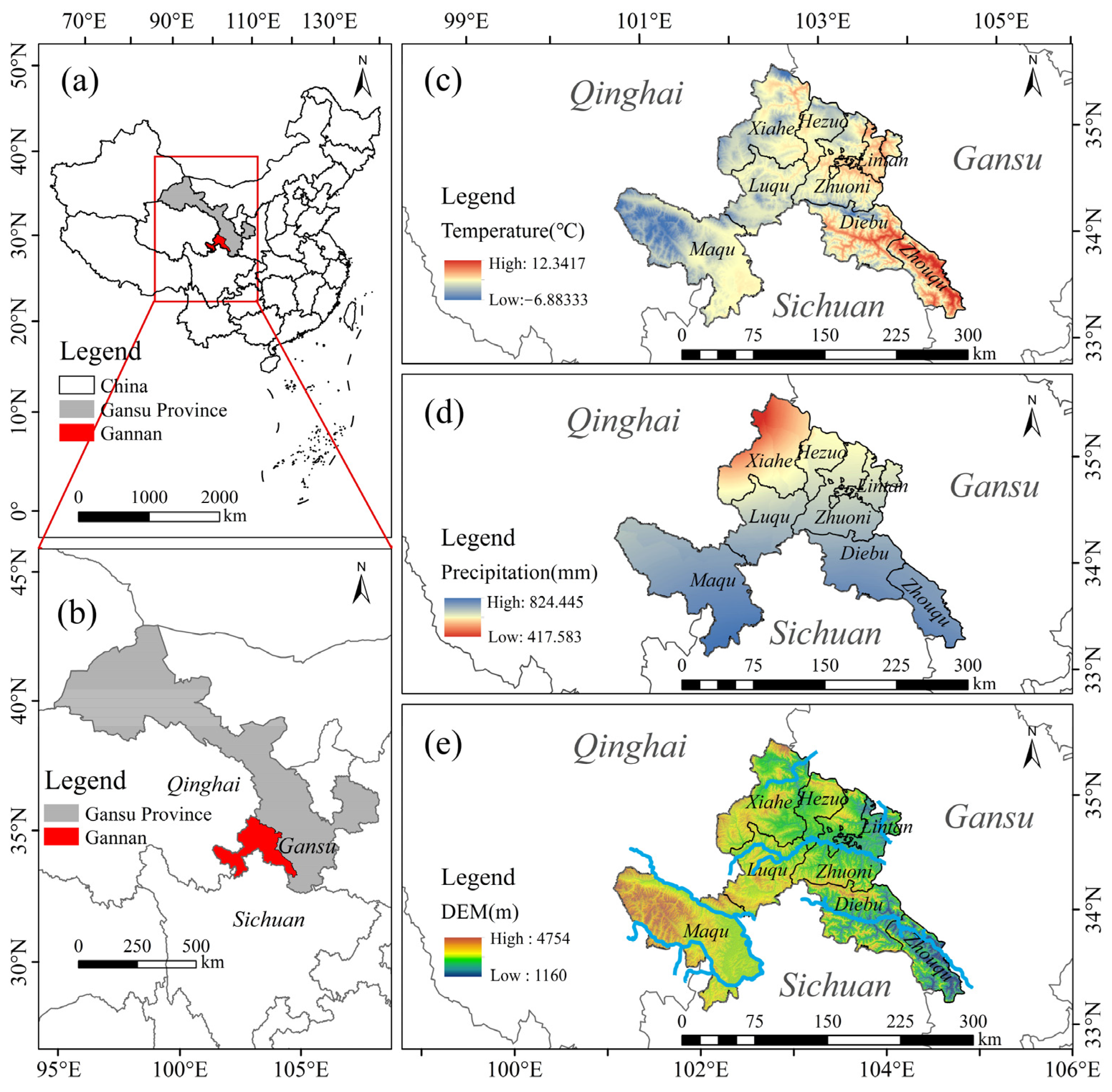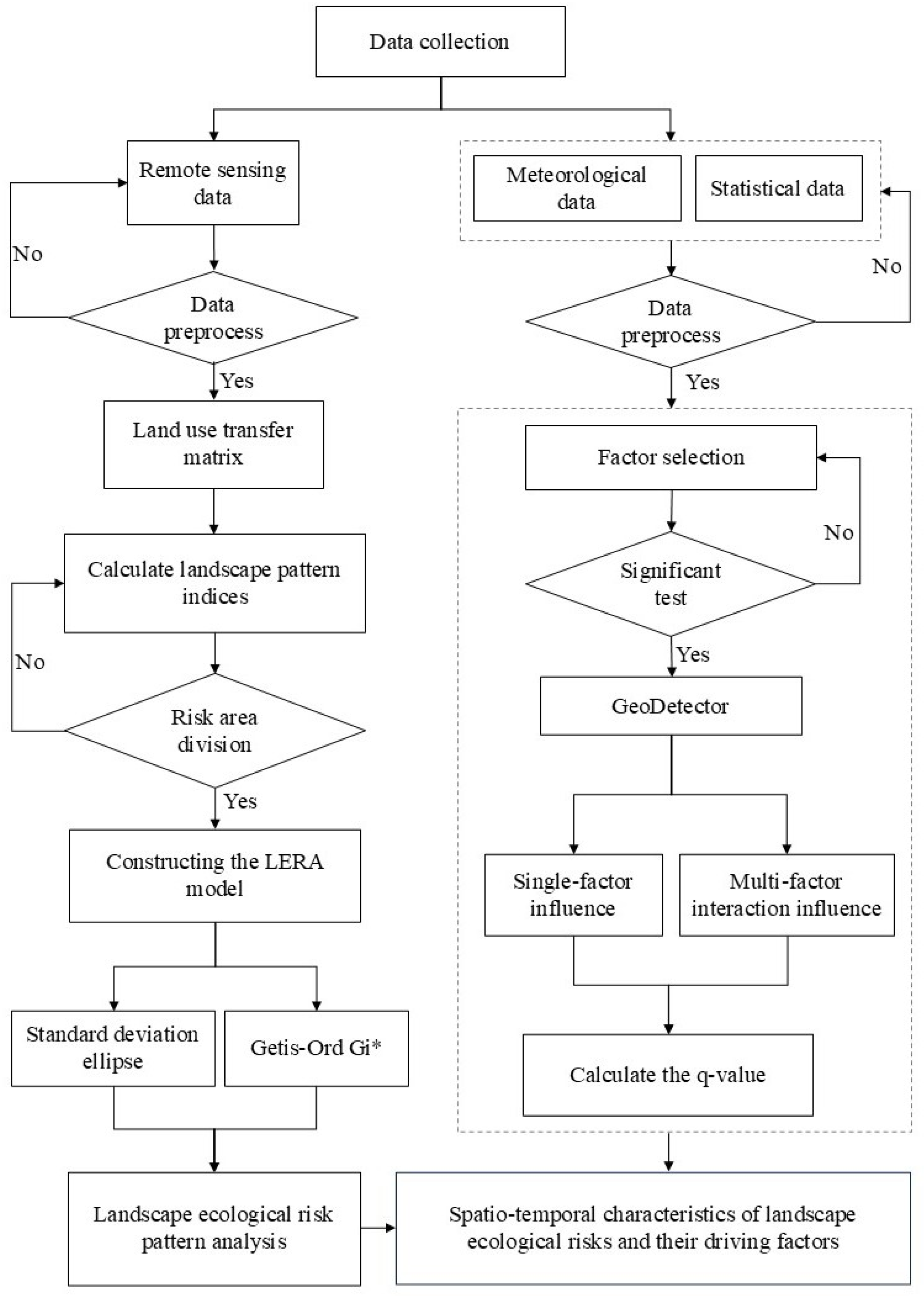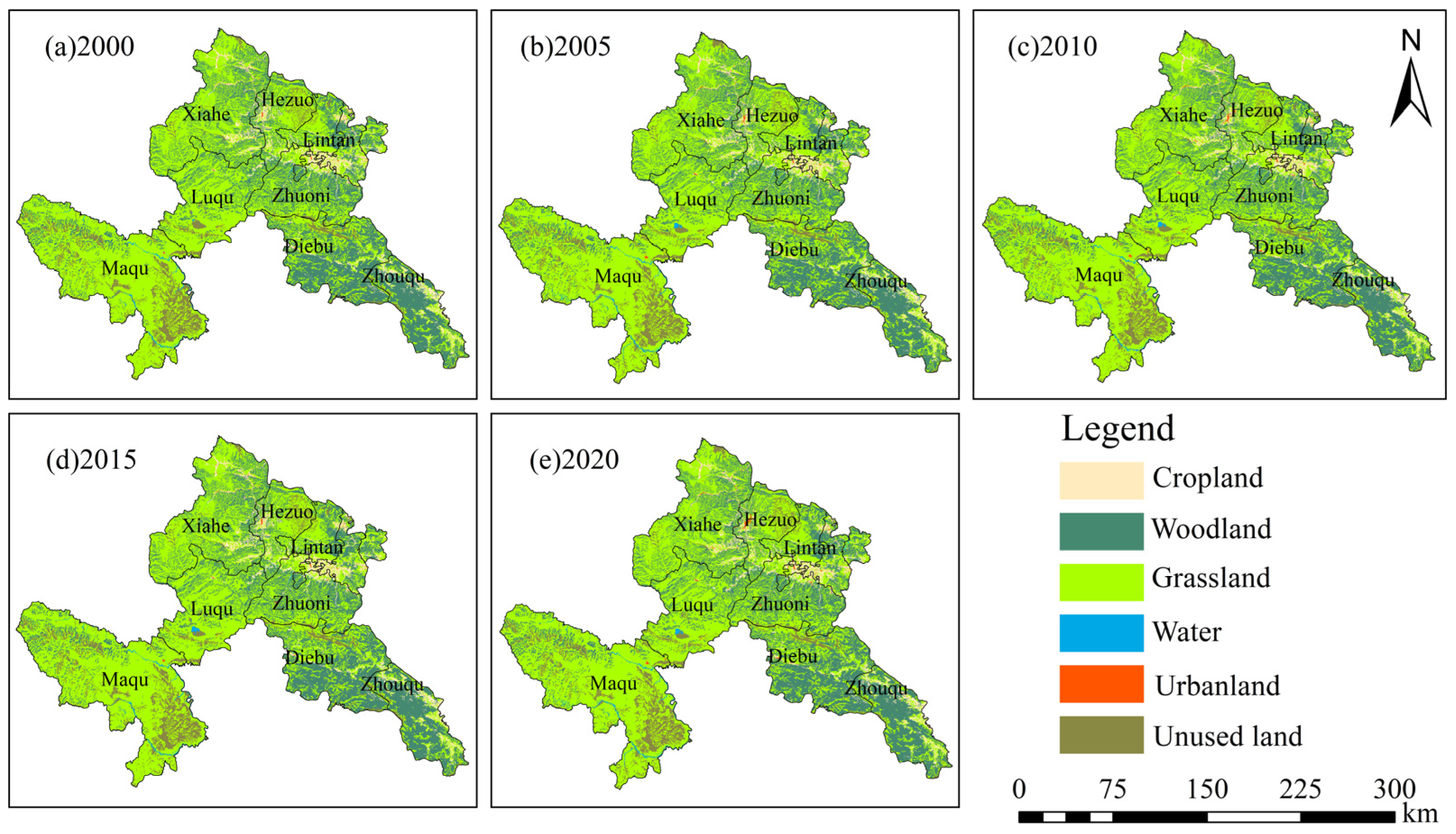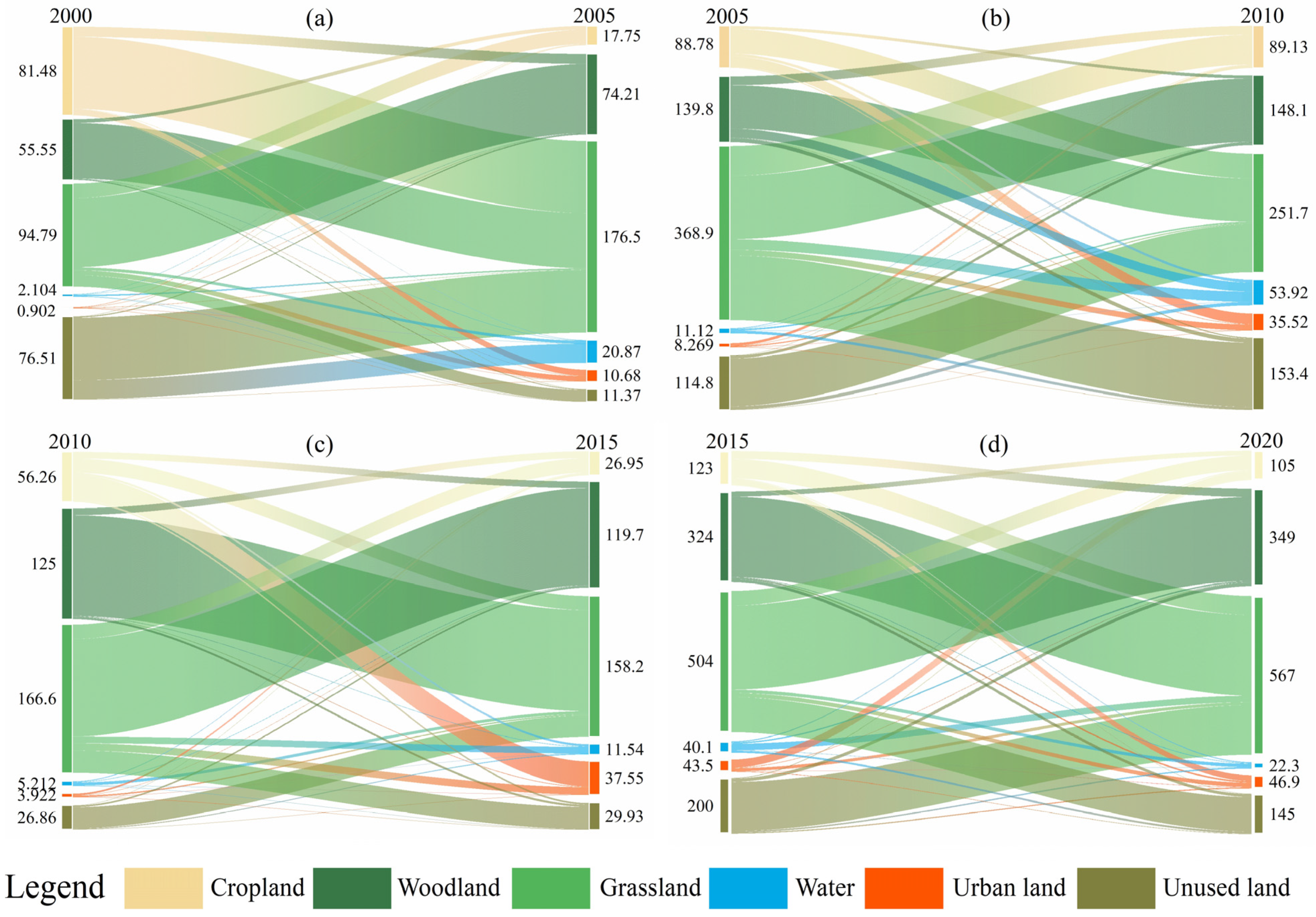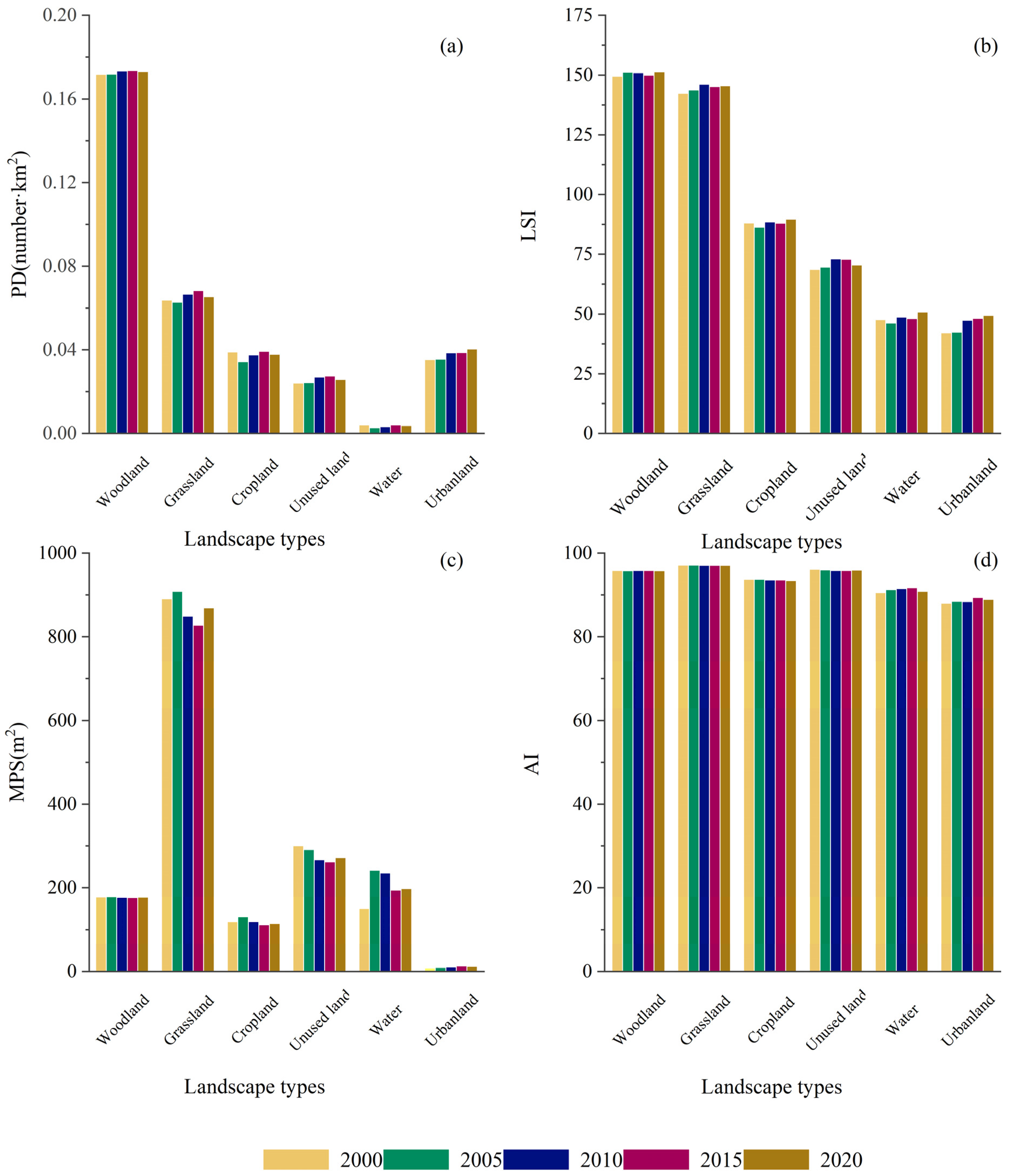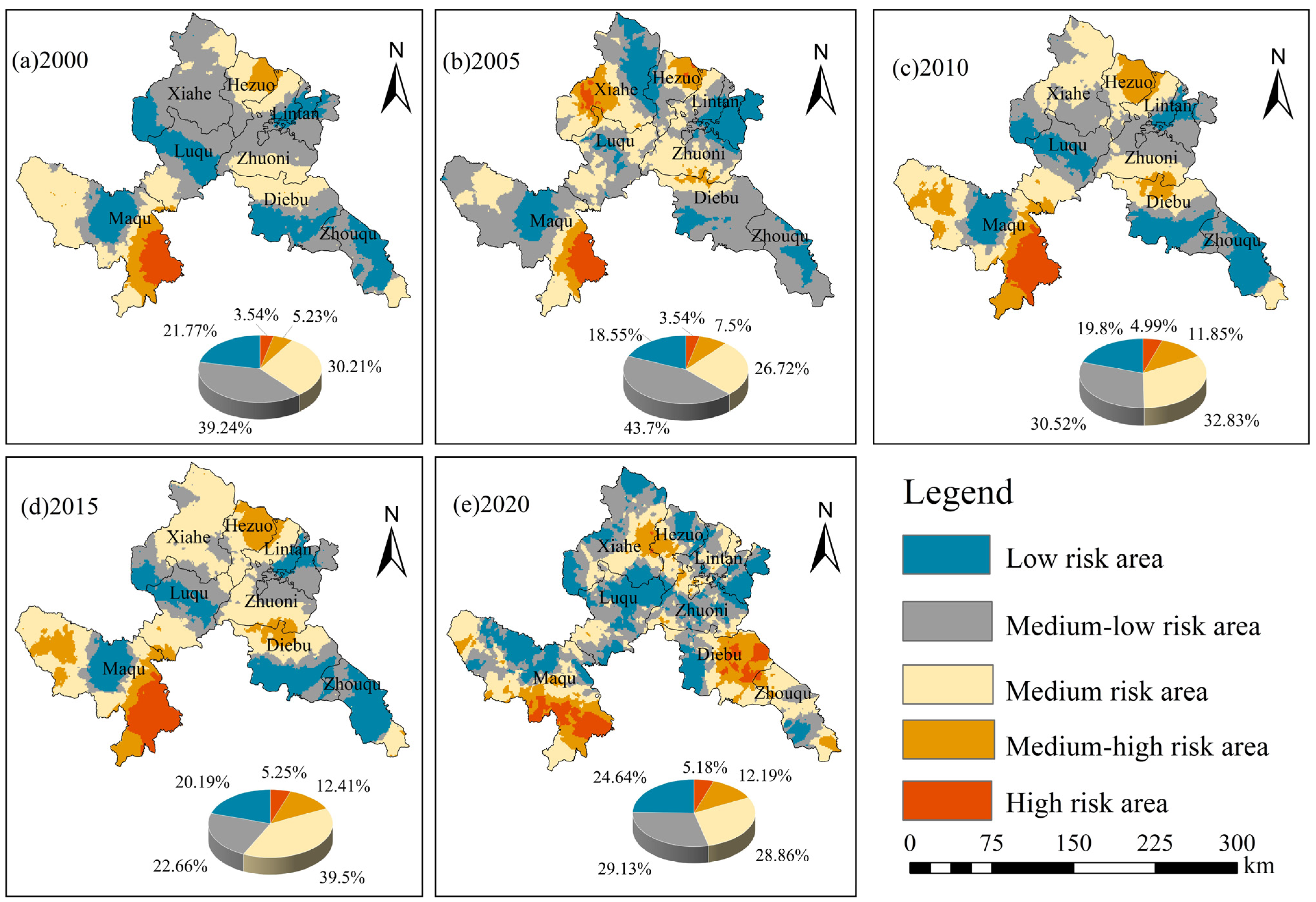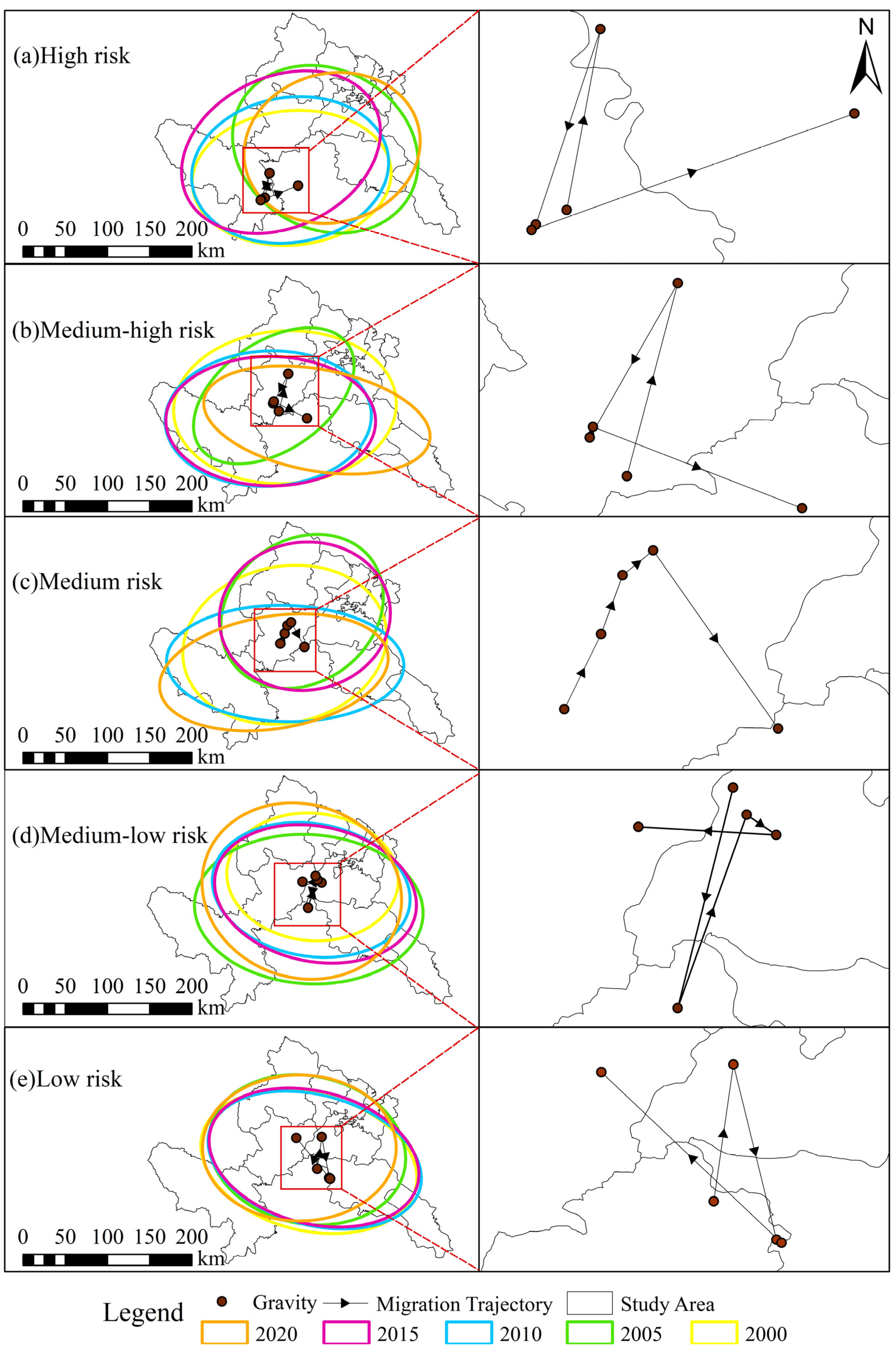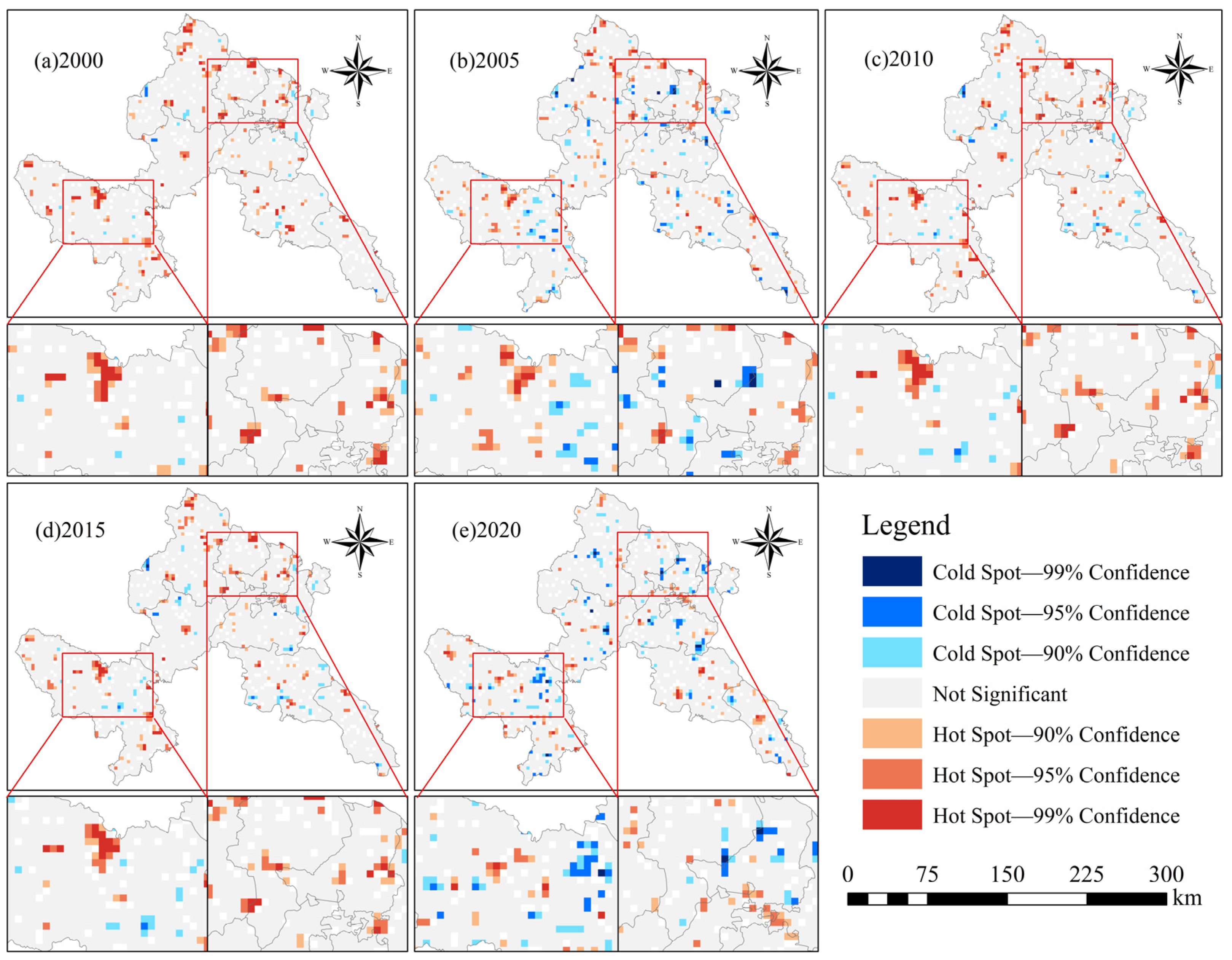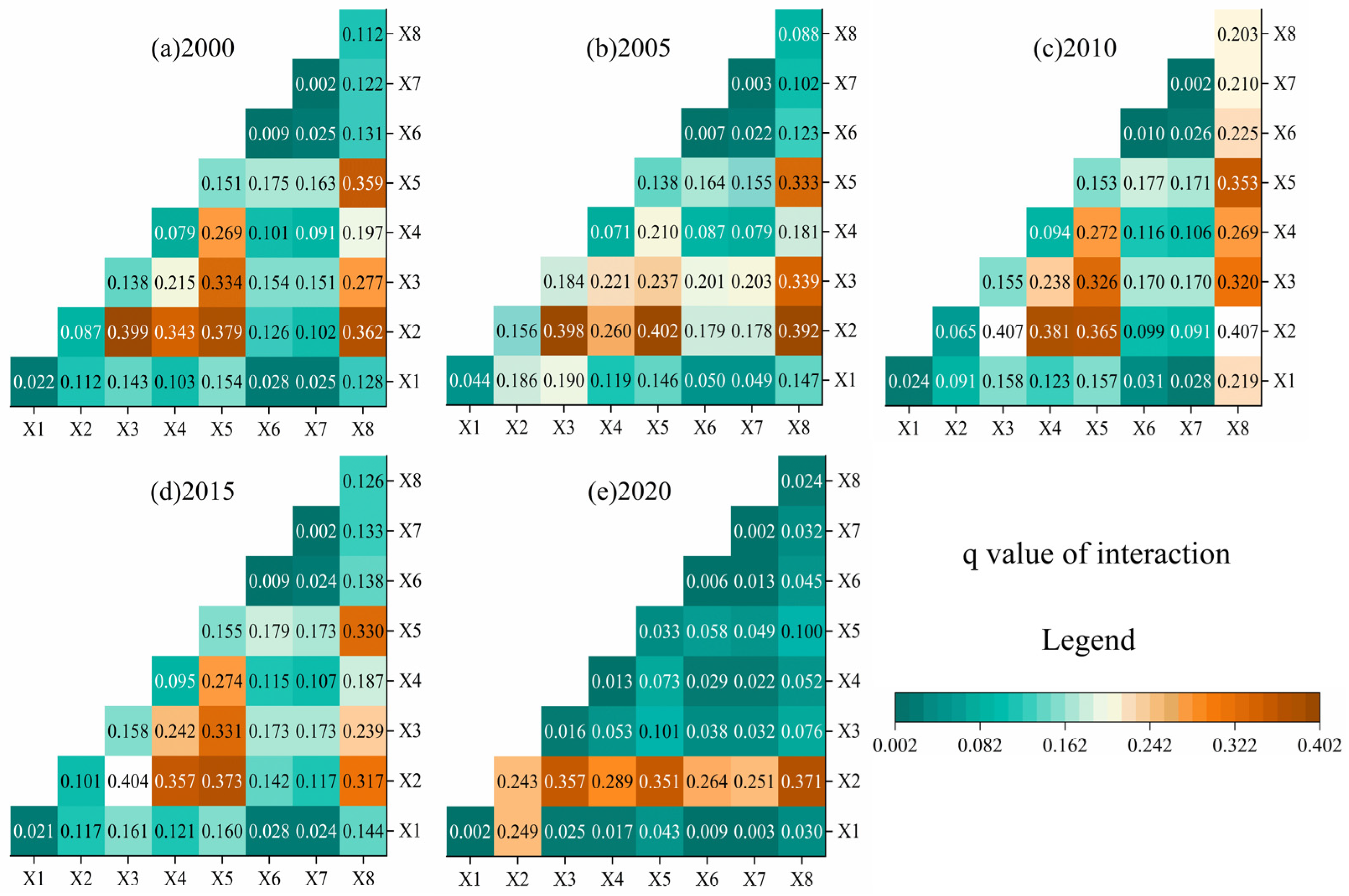1. Introduction
As the effects of climate change and human activities are increasing, ecological risks have become a major challenge for global ecosystems [
1]. The Environment and Development Report 2022 stated that overexploited landscape patterns pose serious ecological risks [
2]. LERA, as a concrete manifestation of ecological risk research, effectively supports regional ecological management and decision-making. Alpine meadow regions are one of the world’s important ecological barriers and water conservation areas [
3]. However, studies indicated that climate change and human activities pose severe threats to biodiversity and water retention functions in these regions [
4]. This is particularly evident across the Qinghai–Tibet Plateau. Landscape ecological risk (LER) issues on the Qinghai–Tibet Plateau have garnered significant global scientific concern [
5]. Therefore, LERA research is of great significance to the sustainable development of alpine meadow regions.
Under the context of climate change and economic development, alpine meadow regions must reconcile developmental demands at the regional scale. Complex risk sources affect ecological security by altering landscape patterns. This necessitates an analysis of the spatiotemporal dynamics and driving forces of regional ecological risk. LERA serves as a mainstream methodology for the integrated representation and spatialization of multi-source risks. It is characterized by its emphasis on the spatiotemporal heterogeneity and scale effects of risk [
6,
7]. At present, the approaches commonly used for LERA include the “source-sink” landscape theory [
8], the Relative Risk Model [
9], and the Landscape Ecological Risk Index (LERI) [
10]. The “source-sink” landscape theory and the Relative Risk Model help to understand the interactions between regional LER and regions [
11]. However, the “source-sink” landscape theory is more difficult to analyze the risk situation under multiple stressors, and it is challenging to validate the robustness of the relative risk model and the accuracy of the results [
12].
With the deepening of research, LERI has been proposed to determine the spatial and temporal evolution of ecological risk in landscapes. Compared with the source-sink landscape theory, LERI can more effectively assess the LER status of areas with multi-source pressure effects under long-term series. Moreover, the results are more accurate and stable as compared to relative risk models [
13]. In recent years, LERI has been used in regional LERA in coastal areas [
14] and watersheds [
15], which indicates that LERI can be widely applied to LERA at different spatial scales. Therefore, we investigated dynamic LERA for alpine meadow regions using LERI.
Furthermore, the methodological approach to driver analysis constitutes a critical aspect influencing Landscape Ecological Risk Assessment (LERA) outcomes. Quantitatively assessing the influence of driving factors provides precise spatial decision-making support for regional ecological risk management and control. Current investigations of LER determinants predominantly employ correlation and regression models [
16]. Traditional regression approaches exhibit limited capacity to analyze synergistic/antagonistic interactions among driving factors and their spatial interdependencies. In contrast, GeoDetector has been widely adopted for examining composite driving forces of LER. This method quantifies the proportional contribution of drivers to LER spatial heterogeneity through its core metric, which is the factor detector’s q-statistic. GeoDetector has the advantages of quantitatively analyzing spatial heterogeneity, efficiently handling high-dimensional data with multiple influencing factors, and effectively dealing with non-linear relationships [
17,
18]. Moreover, GeoDetector was employed in various domains such as environmental science [
19], ecology [
20], urban planning [
21], and agriculture [
22]. Accordingly, we used GeoDetector to investigate the driving mechanisms of LER in a typical alpine meadow region.
Alpine meadow areas are widely distributed in high latitude or alpine zones around the world and have special significance in terms of ecological stability and biodiversity [
23]. China has the largest area of alpine meadows in the world, most of which are found in the Qinghai–Tibetan Plateau (QTP) [
24]. GN is positioned in the northeastern part of QTP with a characteristic alpine meadow landscape with interwoven rivers, lakes, and wetlands due to its alpine plateau hilly terrain and highland climate [
25]. Consequently, GN is a typical area for conducting research on alpine meadow regions. In recent years, many scholars have studied LER in the alpine meadow regions of GN. However, different studies have different focuses, such as ecological risk identification [
26], landscape pattern [
27], grassland vulnerability [
25], and pollution impacts [
5]. The previous studies provide reference and support for this study. However, studies on systemic LER and its driving factors remain scarce [
28,
29]. In addition, the existing LER studies in GN areas focus on district-county scale LERA and require higher spatial precision analyses. It has been demonstrated that studies based on grid scales have higher spatial resolution and more accurate risk identification than district and county scales [
30]. Therefore, we conducted a representative study of LERA and its driving mechanisms in the GN alpine meadow region based on the grid scale.
To investigate the evolutionary characteristics of LER in alpine meadow regions, we conducted the LERA based on fine-grained grid scales. Initially, we analyzed landscape patterns and evolutionary trajectories in the study region using multi-temporal CNLUCC datasets. Subsequently, we integrated the LERI with GeoDetector to examine LER dynamics and identify composite driving forces. This study provides critical support for ecological conservation and sustainable development initiatives in alpine meadow ecosystems.
3. Results
3.1. Landscape Composition Characteristics
3.1.1. Landscape Composition
The landscape composition of Gannan is stable from 2000 to 2020 (
Table 5 and
Figure 3) consisting mainly of grassland, woodland, unused land, cropland, urban land, and water. Grasslands are the most extensive of all landscape types, covering more than 56% of the GN’s total area. Woodlands occupy over 30% of the total area. Unused lands and water constitute a minimal portion, less than 1%.
With respect to spatial distribution characteristics, grasslands are predominantly found in the west, where the plains and plateaus are situated. Woodlands are mainly distributed in the mountainous areas in the south and east. Urban lands are concentrated in counties and cities, with unused lands scattered around them. Water mainly belongs to the Yellow River and the Taohe basin, interspersed and distributed in Gannan. Unused lands are scattered in Maqu.
Among various landscape types, croplands exhibited the most substantial change, illustrating a consistent downward trend (109.29 km2), followed by unused lands (79.92 km2). Urban lands experienced the most extensive expansion (75.07 km2), demonstrating a continuous increasing trend. Grasslands presented the smallest change in area (22.41 km2). In terms of land use dynamics, urban lands and water bodies displayed the highest values of change dynamics, which can be attributed to their relatively small base areas, resulting in more pronounced relative changes.
3.1.2. Landscape Composition Map Trajectory Analysis
Based on the landscape type shift analysis, the results for the four periods (2000–2005, 2005–2010, 2010–2015, and 2015–2020) displayed the following.
From 2000 to 2005, the largest areas of landscape area transferred out and transferred in were both grasslands (
Figure 4), 94.79 km
2 and 176.5 km
2, respectively (
Table 6). Croplands represent the landscape type with the most significant area transferred to grasslands, comprising 21.334% of the total transferred area. Grasslands transfer to woodlands account for the largest share, constituting 20.446%. This transfer primarily occurs in Xiahe, Zhuoni, and Maqu counties (
Figure 5).
From 2005 to 2010, the largest areas of landscape transferred out and transferred in were both grasslands, 368.9 km2 and 251.7 km2, respectively. The shift from unused lands and woodlands to grasslands is large, accounting for 13.896% and 12.550% of all transferred areas. Grasslands are also mainly shifted to unused lands and woodlands, representing 18.683%, and 18.428% of all transferred areas, respectively. Areas of transfer are mainly in Luqu, Zhuoni, and Diebu counties.
From 2010 to 2015, grasslands experienced the largest net transfer of area, both in terms of area transferred out and area transferred in, with 166.6 km
2 and 158.2 km
2, respectively. The majority of the area transferred into grasslands came from woodlands, which represented 29.592% of all areas transferred. The conversion of grasslands to woodlands accounted for 28.533% of all areas transferred. Transferred regions are mainly located in Xiahe, Lintan, and Maqu counties. Additionally,
Figure 5c clearly exhibits the large-scale expansion of urban lands in Hezuo, with the expansion area originating from croplands.
From 2015 to 2020, grasslands consistently had the largest area of landscape transfer both into and out of it, at 504 km2 and 567 km2, respectively. As in 2010 to 2015, the area of grasslands transferred in is predominantly from woodlands, and the area transferred out is also predominantly shifted to woodlands. They accounted for 23.524% and 24.579% of all areas transferred, respectively. Transferred regions are also concentrated in Luqu, Zhuoni, and Diebu counties.
In conclusion, from 2000 to 2020, landscape changes occur mainly between grasslands and woodlands, with a clear concentration in Xiahe, Zhuoni, Maqu, and Diebu. Grasslands to woodlands had the largest area of landscape type transfer, with more than 18% of the area transferred in each study period (
Table 6).
3.2. Results of Landscape Pattern Features Analysis
Landscape pattern features in Gannan have changed over the past 20 years (
Figure 6). According to patch density (PD), the value of woodland reflected a single-peak fluctuation and reached a maximum value of 0.175 in 2015 (
Figure 6a). The trend of unused land and woodland was consistent. All other landscape pattern types had PD values < 0.1. The PD values for grassland exhibited a trend of decrease–increase–decrease, with a peak of 0.0683 reached again in 2015, and the trend in values for cropland and water was consistent with it. The value for urban land, on the other hand, illustrated a continuous upward trend, reaching a maximum value of 0.0403 in 2020.
The LSI values in Gannan fluctuated less during the study period, but all landscape types revealed an increasing trend in LSI values (
Figure 6b). Specifically, woodland has the highest LSI value, followed by grassland, with both types having LSI values above 140. This constituted that the length of the woodland and grassland boundaries is long, which may be related to the increase in area. However, human activity may also have fragmented the patches.
The MPS for woodland, grassland, cropland, and water was basically the same, all exhibited an increasing–decreasing–increasing trend (
Figure 6c). However, the values of woodland, grassland, and cropland all decreased. Additionally, the MPS value for unused land declined by 28.2763 m
2, except for the overall increase in the values of MPS for water and urban land. Among them, grassland had the largest value and the largest landscape patch size with yearly values, all >800 m
2, with the best internal connectivity.
The AI values for each landscape type did not differ much and did not vary much from period to period, being around 90 (
Figure 6d). Among them, grassland has the largest value, indicating strong connectivity between grassland patches and a high degree of ecological stability, while urban land has a low degree of landscape aggregation due to a high degree of human activity impacts.
In summary, PD exhibited a unimodal fluctuation, peaking in 2015. LSI demonstrated a consistent upward trajectory across all landscape types. Except for water and urban land, MPS displayed a declining trend. AI remained stable throughout the study period. Notably, woodland registered the highest PD and LSI values among all landscape types, whereas grassland exhibited the largest MPS and highest AI values.
3.3. Spatiotemporal Pattern of LERI
The results of the LERI assessment of GN were analyzed by standardizing and classified into five levels: low risk area (LERI ≤ 0.48), medium-low risk area (0.48 < LERI ≤ 0.53), medium risk area (0.53 < LERI ≤ 0.58), medium-high risk area (0.58 < LERI ≤ 0.65), and high risk area (LERI > 0.65).
Figure 7 demonstrated the spatial distribution across the five levels of LERI.
The spatial variation in LERI is notable, with high-risk zones exhibiting a pattern of progression from the southwest to the northeast. Between 2000 and 2020, the combined areas of the medium-risk and medium–low-risk zones comprised approximately 60%, mainly in Luqu, Xiahe, Lintan, and Zhouqu. The low-risk area rose from 21.77% to 24.64%, primarily in Maqu, Luqu, and Lintan. At the same time, the high-risk and medium–high-risk areas remained relatively low, approximately 10%, but reflected an upward trend, increasing by 1.64% and 6.96%, respectively, and were scattered in areas such as eastern Maqu, urban areas of Hezuo, and central Diebu.
To delve deeper into the transitions of LER, we conducted centroid migration and directional distribution analyses for each risk level using SDE (
Figure 8,
Table 7). While the centroid of high-risk areas clustered in the southwest of GN, other risk levels exhibited relatively uniform centroid distribution across GN. The southwestward bias of high-risk centroids primarily resulted from the extensive high-risk coverage east of Maqu. Centroids of low risk and medium-low risk areas shifted westward, whereas those of medium risk, medium–high risk, and high risk areas migrated eastward.
Regarding directional evolution (2000–2020), high risk, medium–low risk, and low risk areas consistently maintained a southwest–northeast-oriented major axes. Their x axes shortened with reduced dispersion. Conversely, medium–high risk areas displayed a northward shift in orientation over the period from 2000 to 2005, with axis direction changing from 85.82° to 52.99°. From 2005 to 2020, their primary axis orientation transitioned from southwest–northeast to southeast–northwest, reaching 100.52°. This coincided with X axis elongation and increased dispersion. Medium risk areas shifted northward between 2000 and 2005 (76.02° to 91.05°), then southward in the period 2005–2010 (91.05° to 47.96°), and finally northward during the period 2010–2020 (47.96° to 79.86°), accompanied by X axis lengthening and enhanced dispersion.
Collectively, high-risk areas developed with southwestern bias yet demonstrated a northeastward migration trend from 2000 to 2020. Low risk and moderate–low-risk areas exhibited pronounced westward development trends. These three risk levels exhibited decreased dispersion. In contrast, medium risk and medium–high risk areas developed northward with increased dispersion.
The spatial distribution of LER cold and hot spots was analyzed utilizing the Hot Spot Analysis tool (Getis-Ord Gi*) in ArcGIS, as illustrated in
Figure 9. The mean
p-value for the hot spot areas (Z(Gi) > 1.9) was 0.02, while that for the cold spot areas (Z(Gi) < −1.9) was 0.03, both demonstrating statistical spatial significance. The LER hot spots in the GN region were predominantly concentrated in urban areas, such as the urban core of Hezuo, Oula Town in Maqu, and the urban zones of Luqu and Zhuoni. Anthropogenic construction of towns and industrial parks has exerted substantial ecological pressure. In contrast, cold spots were less abundant than hot spots and were primarily located within ecological protection zones and plateau wetland areas. Furthermore, a comparison of the LER cold and hot spot distributions across the five periods revealed that the number of hot spot clusters in 2020 was significantly lower than in the previous four periods, whereas the number of cold spot clusters was markedly higher. This denotes a positive trend in the LER status of the GN region.
3.4. Landscape Ecological Risk Driver Analysis
3.4.1. Detection Factor Influence
The factor detector was employed to assess the extent of each factor’s influence on the LERI. By determining the q-value for factors, we determined the force of each factor from 2000 to 2020 (
Table 8).
The factors were ranked in descending order of their influence on LERI: elevation > annual average temperature > cumulative annual precipitation > GDP > slope > population density > distance from road > distance to water (
Table 8). The results displayed that all independent variables except X7 distance to water and X1 population density in 2020 passed the 0.01 level of significant test, proving that the results are credible.
Table 8 implied that the q-values for elevation and annual average temperature were larger. The spatial pattern of the effect of altitude on LERI was generally the largest, with the first q-value in both 2005 (0.18) and 2015 (0.15), showing a fluctuating downward trend. Secondly, the spatial pattern of LERI was slightly less influenced by annual average temperature than elevation, which was the first in 2000 (0.14) and had q-values above 0.138 in all three periods from 2005 to 2015. The next influential factors are cumulative annual precipitation and GDP, with 2020 cumulative annual precipitation having the highest impact value (0.24), 2010 GDP having the highest impact value (0.20).
3.4.2. Analysis of Interaction Between Factors
The interaction detection results (
Figure 10) revealed that factor interactions contributed to LERI through both bidirectional and nonlinear enhancements. The interaction effect exceeded the combined effects of the individual factors, suggesting mutual reinforcement among the driving factors.
From the heat map, we can see that the interplay between elevation and cumulative annual precipitation had the greatest impact on LERI, exceeding 0.35. Interaction was greater than the sum of the two, and their interactions were in the top two places. Second, the interactions of annual average temperature with annual precipitation (>0.35) and GDP with annual precipitation (>0.31) also had a significant effect on LERI, with interactions being greater than the sum of the two.
In summary, there are significant synergistic effects among the different influencing factors of LERI. Their collective influence is greater than that of individual factors. Notably, the interactive effects of precipitation and elevation play a particularly prominent role.
5. Conclusions
This study analyzed changes in landscape patterns and LER from 2000 to 2020 and explored the causes of LER.
The results of the study implied the following: (1) From 2000 to 2020, the landscape composition of GN remains stable, with grasslands and woodlands being the dominant landform types, both showing an upward trend. Grasslands were primarily found on the western plateau, while woodlands predominated in the eastern and southern mountainous regions. Landscape changes primarily occurred between the grassland and the woodland, with notable concentrations in Xiahe, Zhuoni, Maqu, and Diebu. (2) PD and LSI in the study area reflect an upward trend, AI remains stable, and MPS for major landscape types, such as woodlands and grasslands, illustrates a declining trend. (3) LER is decreasing, with high-risk regions primarily in eastern Maqu, Hezuo, and central Diebu. The centers of low and medium–low risk areas have migrated westward, whereas centers of medium–high and high-risk regions have shifted eastward. (4) Among the natural and social factors influencing LER, altitude exerts the greatest influence, with even stronger interactions among different factors. Precipitation demonstrates the greatest interaction with other factors. Natural factors, such as climate and topography, are more powerful forces on LER than socio-economic factors. Consequently, protective measures, such as fencing and drone-assisted monitoring should be implemented in high risk regions, including western Maqu County. Future research should integrate multi-source spatial data to examine landscape ecological risk (LER) dynamics and predictive research.
